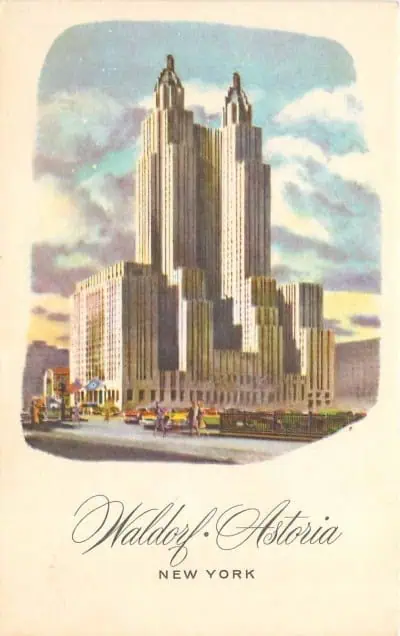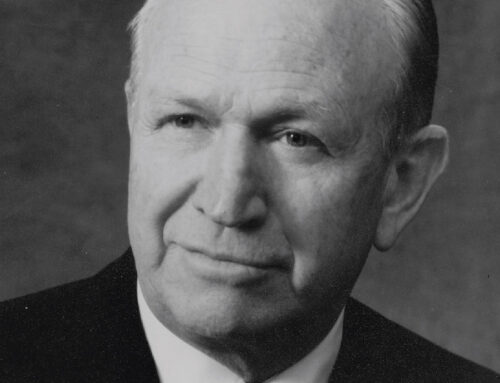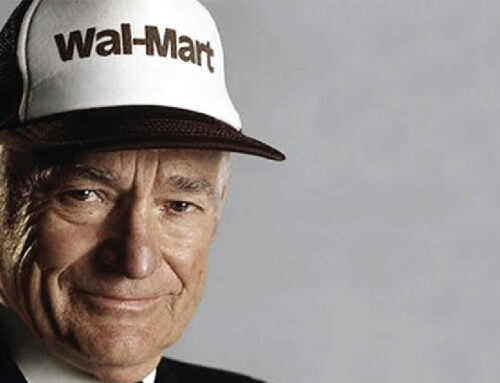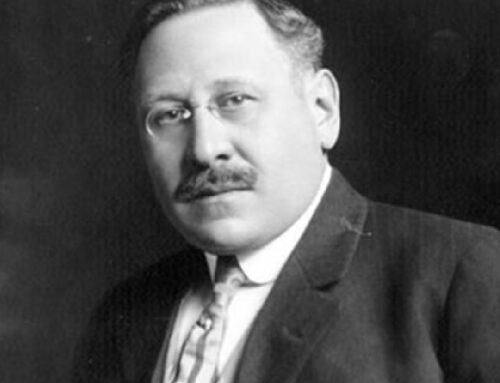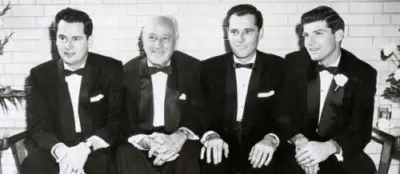
Conrad Nicholson Hilton was born to wealth. His father, “Colonel” A. H. “Gus” Hilton, was the leading merchant and trader in the tiny sun-baked mining village of San Antonio, New Mexico. Young Connie wanted to become a banker, and at age thirty-one he went to Texas to make his fortune in that industry. When a man who offered his bank to Connie raised the price, the young Hilton crashed in a nearby seedy hotel. He saw how full it was and bought it, instead of the bank, with his $5,000 in savings and the backing of friends. Gradually building a small chain of Texas hotels, Hilton almost lost them all three times in the Great Depression. But his ambition and persistence kept him going through the worst of times. He eventually set his sights on the greatest hotels of Chicago and New York, and over time created the first major global chain, the largest hotel company in the world. This is the story of Conrad Hilton.
“All a man has got is his word. If you can’t trust what he says, how do you know he’s there at all?”
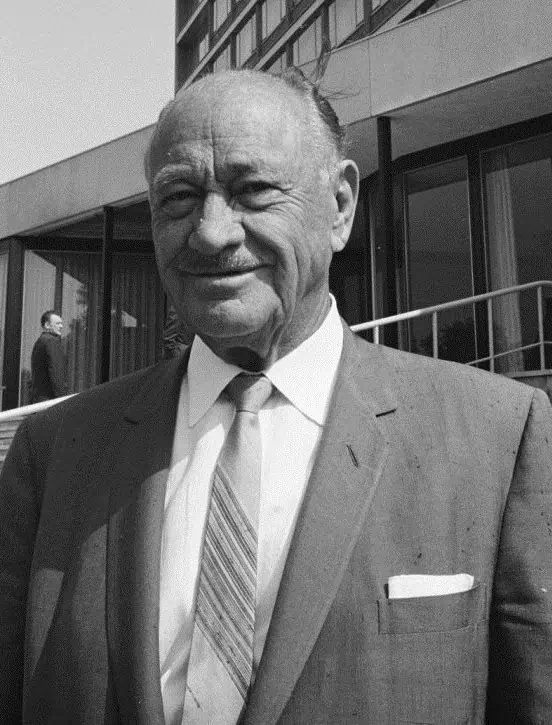
Photo by Harry Pot – Nationaal Archief Fotocollectie Anefo, CC BY-SA 3.0 nl
Building the Foundation
Augustus H. Hilton, born in Norway in 1854, came to the United States seeking new frontiers. Coming through Iowa, he found those frontiers in the dry, isolated village of San Antonio, New Mexico Territory, when he arrived in the 1880s, just after the Santa Fe Railroad came to town. He had also fallen in love with Mary Laufersweiler of Fort Dodge, Iowa. A devout Catholic of German heritage, Mary’s father preferred that they settle in “the States,” as New Mexico would not become a state until 1912. He also required that “Gus” Hilton respect her religion. In 1885, the two were married. They had eight children, seven of whom survived to adulthood. The second to come along was Conrad Nicholson Hilton, on Christmas day, 1887. For each new child, Gus added a room to their plain but rambling house.
Gus was a large man in every dimension—backslapper, storyteller, merchant, trader, financier of miners. Over time he built the largest store in San Antonio, grubstaked miners, and accumulated wealth and respect in both San Antonio and the nearby larger town of Socorro. Young Connie had a full life, raising and selling corn and other vegetables, learning Spanish in a town with only a few “Anglo” families, perfecting his piano skills, and working in his father’s store starting at $5 per month.
While Connie learned business and trading from his father, he may have learned more from his refined and pretty mother, Mary. She instilled her religion so deeply in him that he prayed daily and attended Mass whenever he could. Taking Communion and the sacraments became a core part of his life. And Mary insured he was educated, sending him off to Goss Military Academy in Albuquerque when he was eleven, then the New Mexico Military Institute in Roswell, and finally St. Michael’s College in Santa Fe, where he was instructed by priests.
One priest told Connie of St. Joseph, the patron saint of workers and builders. He told Connie that he would always be in good stead if he said a “Hail Mary” followed by “St. Joseph, pray for us.” Connie did this every day for the rest of his life.
In military school, Connie learned that “all a man has got is his word. If you can’t trust what he says, how do you know he’s there at all?” In later years, Connie would frustrate his lawyers and his publicity folks by refusing to bend the truth in the slightest.
Admittedly not much of a student, Connie did excel at math. He later said, “A thorough training in the mental disciplines of mathematics precludes any tendency to be fuzzy, to be misled by red herrings.” Throughout his business career, Connie was able to formulate things quickly and simplify problems.
The frontier was rough. Once his father and six other men had been attacked by Apache raiders; only Gus and one other man escaped alive. But Gus had a philosophy about violence, saying, “Either you never carry a gun or you always do. One way you depend on your wits. The other on your draw. … I’ve seen a lot of men stone dead from drawing too late.” Gus did not carry a gun.
Gus’s store grew and grew, adding a post office, telegraph office, lumber warehouses, and a dealership in the best wagons and buggies from the Studebaker company of Indiana. Proving his bargaining and trading skills, Connie worked his way up to making $15 a month.
By the age of fifteen, Conrad Hilton was six feet tall, a good dancer, bridge and poker player, pianist, tennis player, and lively conversationalist. He was inspired by the book Optimism by the blind and deaf Helen Keller, and came to believe “pessimism to be a sin.”
The next year, in 1904, Gus sold a mine he owned for $110,000 ($3 million in today’s money). The family was rich! To celebrate, Gus took the family to the St. Louis World’s Fair, also the site of the first Olympics held in the United States. Connie and his siblings were beginning their exposure to a broader world, made wider when Gus moved the family to Long Beach, California, a block from the beach. But even there, Connie got a newspaper route.
Then, in 1907, a financial panic (recession) swept the nation. Gus’s inventories dropped in value and business dried up. They were broke. So the family returned to San Antonio and turned their big house into a boarding house, serving up Mary’s excellent cooking. Connie worked at the store from 8 a.m. to 6 p.m. every day and he and his brother Carl met each train arriving in town—at noon, midnight, and 3 a.m. Connie was, for the first time, a bellhop.
Gradually the Hiltons got back on their feet. Connie took his sister and her two friends—“the Hilton Trio”—on a tour of New Mexico with mixed results. Finally, at the age of twenty-five, Gus made him manager of the store and part-owner. But Gus could not leave him alone, and “micro-managed” the store. Reacting to his impulsive and “exhausting” father, Connie learned “never to show urgency, irritation, or uncertainty.” He also came to believe in delegation, and later said, “When I had carefully selected a man for a job I left him alone, knowing that either I had been right in my selection or I had been wrong. But he had to have a free hand to show which.”
Conrad Hilton—Politician, Banker, Soldier, Banker
The ambitious young man became the youngest member of the new New Mexico State Legislature when it was formed in 1912, elected as a Republican. His father had supported his opponent, as he wanted Connie to stay home and work in the store. While Connie served on eight committees and introduced nineteen bills (nine of which passed), he soon grew frustrated with the bureaucracy, slowness, cheating, lying, and inside deals of politics.
In his short political career, Connie came to realize he might have to make speeches, and was very uncomfortable with the idea. He bought a self-help book on public speaking, and rehearsed his talks in the desert with his dog. Finally, he built up the courage to try the flowery rhetoric techniques he had learned on his mother. She said, “All those trimmings are sinful. You are hiding yourself behind gestures. If you’re afraid to be you, son, you’re throwing dust in God’s face. He made you. If you have confidence in Him, you’ll relax and be just what you are.” Connie followed her advice and went on to become a compelling speaker.
“There is a yoke of responsibility that attached itself firmly the minute someone had entrusted me with their capital.”
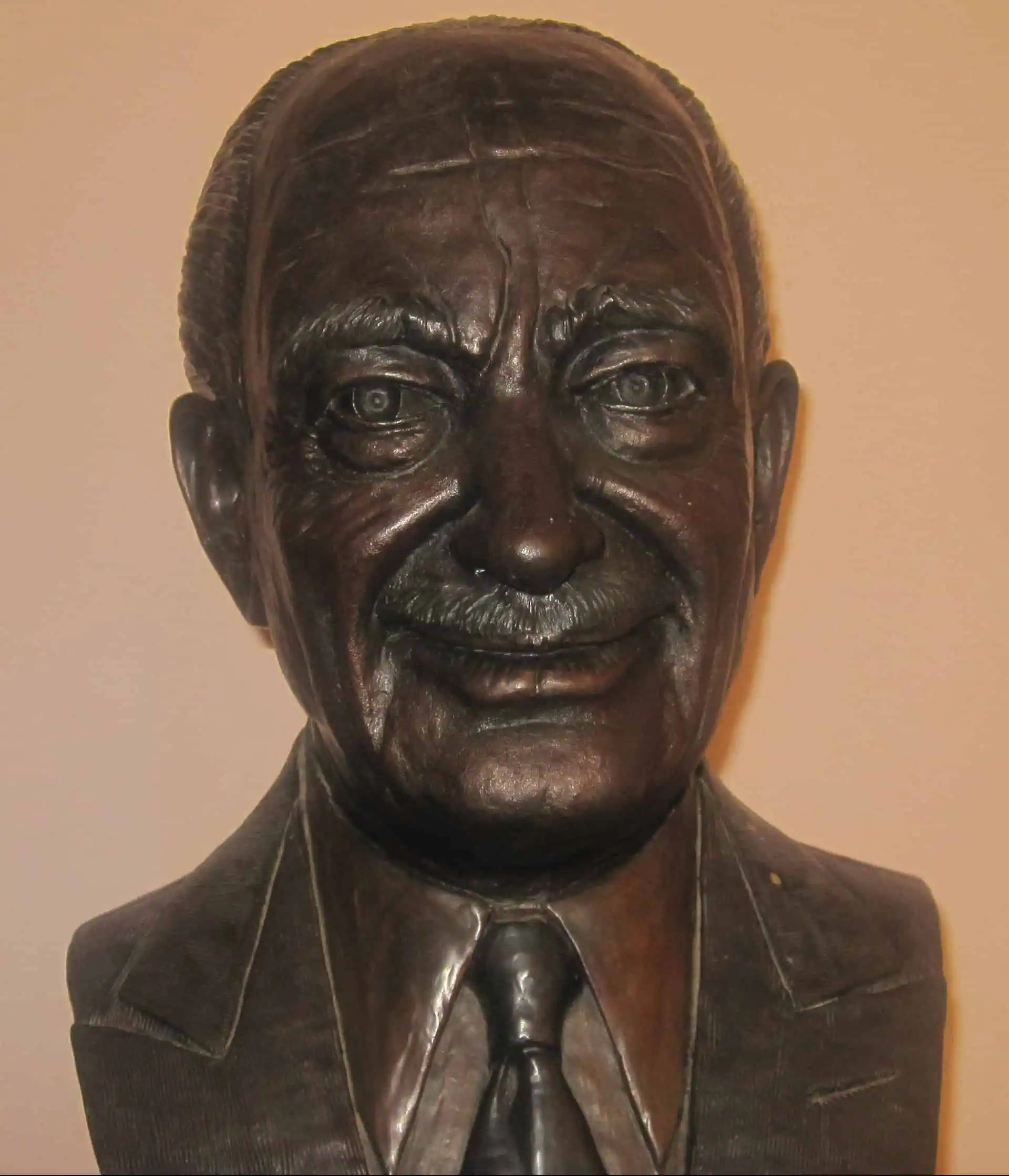
Over time, Connie developed the desire to become a banker. He took his $2,900 in savings and raised $30,000 to found the New Mexico State Bank of San Antonio, including a small investment by his father. But when the newly formed board of directors met, they elected an old banker as president, freezing out Connie. Upset, he went back to all the shareholders and gathered enough proxies to get control. But when he showed up at the stockholders’ meeting, there had been a run on the bank, and it was broke. He believed the old man had started the run in order to prevent him from getting control. In any case, Gus arranged $3,000 in loans from out-of-town banks to save the day, and Connie was elected a vice president.
In raising money, Connie said, “There is a yoke of responsibility that attached itself firmly the minute someone had entrusted me with their capital.” He felt this responsibility for the rest of his career.
By 1916, war was on the horizon. Gus sold the store, and Gus and Connie sold the bank. In 1917, Connie enlisted, which opened his eyes to a broader world. He had been a very big fish in a very little pond; now he was to cross the ocean. Off to Officers’ Training Command at the Presidio, he saw San Francisco for the first time, and fell in love with the city as so many others have done. Then in Washington State he saw serious rain for the first time. Next was a stop in Jacksonville, Florida, and finally orders to leave for France. Before departing, he and his new army buddies visited New York (which he found “impenetrable”), and he visited his married sisters now living in Boston and New Jersey. On March 14, 1918, Connie and his army friends sailed for France.
While he never saw battle, he was stationed a few miles from the front, and saw many overhead dogfights between fighter planes. He traveled all over France and was finally stationed in Paris when the armistice was signed that November, two million people celebrating in the streets.
Just before his return to the States, in January of 1919, sixty-four-year-old Gus died when his Model T skidded on ice and rolled into a ditch. Not only did that end one era of Connie’s life, but as a returning soldier, he was adrift. He and his many new friends from military service had been changed by the experience. They returned home with a broader view of the world, but were uncertain as to what to do next. Some wanted to return to their hometowns. Others had seen new horizons. The most appropriate song of the era was “How’re You Gonna Keep ‘em Down on the Farm, After They’ve Seen Paree?”
Connie returned to Socorro and San Antonio, but now that world seemed small. The store was no longer his, and his father was gone. He traded mohair for a while, using his well-honed skills. But he was restless, and still wanted to become a banker, perhaps even build a chain of banks across New Mexico. His mother, always supportive and willing to let her children go where they needed to go, said, “You’ll have to find your own frontier, Connie. If you want to launch big ships, you have to go where the water is deep.”
So Connie went to Albuquerque and looked into banking, but everyone said it was a fool’s mission, that the town had plenty of banks already. He visited an old friend on his deathbed, and the man told him to go to Texas, that wherever there was oil, there was activity, even in merchandising and banking. Connie jumped on the next train to Texas.
Searching for a bank to buy, he stopped in Wichita Falls, then Breckenridge, then Cisco, all towns alive with nearby oil activity. In Cisco he found a bank for sale for $75,000. While he only had $5,000 in savings, he figured he could raise the rest from family and friends if he found the right deal. He agreed to buy the bank, only to have the seller raise the price $5,000, which did not sit well with Connie. He decided to spend the night in town, and went to the only option: the run-down, dirty Mobley Hotel.
The lobby was mobbed. People were sitting everywhere, waiting for a room. Connie made his way to the front desk, and was told, “Come back in eight hours, when we swap out the rooms.” They were running three shifts a day, keeping full-up. Connie asked the man, “Do you own this place?” to which the man replied, “I do. I am tied to it with an anchor and chain. Every nickel I’ve got is sunk in this glorified boarding house when I ought to be out there in the oil fields making real money.” Connie pointed out that the owner appeared to be making plenty of money. The owner replied, “(only) if you’re willing to settle for the hotel business when guys are turning into millionaires overnight (in the oil fields).”
Connie spent the next three hours going over the books before he agreed to buy the Mobley for $40,000 (about $600,000 in today’s money). He called his friends about investing, and it took some persuading. Those who saw the place thought it a disaster. Connie told them it was “a cross between a flophouse and a gold mine.” He raised $20,000, borrowed the rest from a Cisco bank, and was (unexpectedly) in the hotel business. Connie wired his mother, “Frontier found. Water deep down here. Launched first ship in Cisco.” The telegrapher stopped him to make sure he got the message right, saying, “There’s never been a boat in Cisco. There ain’t even any water.”
The year was 1919; Connie was thirty-one years old, perhaps a bit late to enter a new industry in that era. But this first step would change the hotel business for the next century to come.
Conrad Hilton, Texas Hotelier
Connie and his partner and first manager, L. M. Drown, slept in the office of the Mobley because they could rent out their beds to guests. They sat in their desk chairs and did not sleep well. In the middle of one night, Connie awoke with an idea, and drug the drowsy Drown out into the lobby. “Look at all this wasted space!” he cried. Drown thought he was crazy, but Connie had the front desk shortened in half, opening up an area for a newsstand and tobacco shop. Next, he got rid of a potted plant and replaced it with a tiny novelty shop. He did away with the dining hall, providing space for about twenty more tiny rooms. Thus began a lifelong crusade against “waste space.”
“Look at all this wasted space!”

His next innovation was to bring the army’s “esprit de corps” to the hotel business. He called all twenty-some employees to a meeting and surprised them with a pep talk, uncommon for the times or the industry. “Ninety percent of the Mobley’s reputation is in your hands.” He backed up his words with incentives, and instilled pride in the workers. Even today, the leading hotel companies (including Hilton) rank high in most lists of “the best places to work.”
When one of his investors who helped manage the hotel demonstrated his dislike of people and was rude to customers, Connie bought him out—for double the $5,000 the man had invested. Connie said it was cheap at the price, and soon learned, “All my life long I have only been as good as my associates.” His good managers went on to spend their entire careers working for this honest, caring man.
Next came the worn-out old Melba Hotel in Fort Worth. He couldn’t get a loan on it, as everyone except Connie thought it needed to be torn down and carted away. So instead of buying it, he leased it for $25,000, then he and old army buddy Major Jay Powers spent eighteen-hour days cleaning it up. Within ninety days, the safe was bulging with money as Connie applied his principles, including insisting on “plenty of soap and clean linens.” His advertising slogan became “Minimax”—Minimum Charge for Maximum Service.
Then he leased the 150-room Waldorf in Dallas, named after the famous New York hotel, the Waldorf-Astoria. He put another army buddy in charge of it.
In 1921, the country had another severe recession, but it did not slow his ventures down. In that year, his share of the profits of the three hotels amounted to $6,000 per month (over $80,000 in today’s money).
Then came the lease on the Terminal Hotel in Fort Worth. But here he made a mistake. He took in an eager partner, D. E. Soderman, who had made a small fortune in the restaurant business. The hotel started flowing cash, and Soderman drank up his profits in whiskey. He started falsely accusing another partner, Connie’s friend Major Powers, of stealing his money and his wife. In April of 1922, Powers was manager of the Dallas Waldorf. Soderman walked into the lobby and shot Powers in the head, killing him instantly. Connie was shattered by his friend’s death, and Soderman went to prison, but vowed to get Connie when he came out. Ultimately, Connie remembered his father’s advice about guns and violence, and had a priest go meet with Soderman upon his release from prison and give him some money, sending Soderman away to start anew.
Conrad Hilton, the Builder
Connie continued to buy old run-down hotels around Texas and fix them up, but he finally tired of this and decided he needed to build one of his own. He found the right site, at Main and Harwood in downtown Dallas, to build the first true Hilton Hotel, but needed a million dollars to build it. Having become an expert at creative financing, he convinced the man who owned the land to lease it to him for ninety-nine years (an unusual length of time in Texas) at $31,000 a year. This allowed Connie to use his money to build the building rather than tying it up in an expensive land purchase.
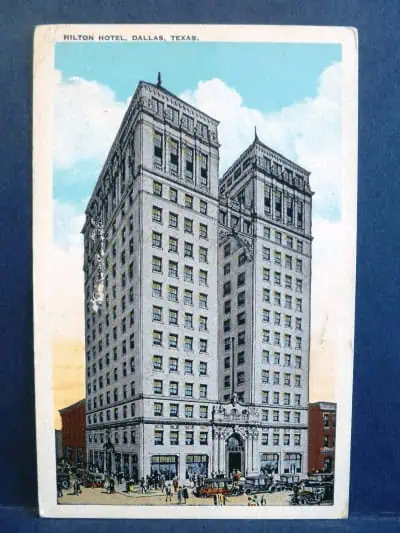
But a million dollars was still well beyond his reach. He could put up $100,000 and thought he could raise $200,000 from his old backers, leaving him $700,000 short. He convinced the landowner to let him use the building and land as security, and got a $500,000 bank loan. But the loan was only paid to him as he finished each floor, and if he ran out of money before the building was completed, the loan would be called and cancelled. He borrowed $150,000 from the contractor, and another $50,000 from Dallas banker Robert Thornton. He sold the Mobley and the Dallas Waldorf to come up with his share of the money. (Hilton went on to buy and then sell many hotels, saying, “To me it is part of the hotel game, or any business, to let the past go cleanly if you are sacrificing it to an expanding future.”)
With construction underway, Connie was “on top of the world.” Soon, though, storm clouds gathered. Construction of the Dallas Hilton cost more than expected, and there were construction delays. The bankers saw the trouble and began calling some of the loans. Connie averted disaster with a $50,000 loan from a hotel competitor who was Jewish, cementing Connie’s belief in people of all faiths, and in the faiths working together.
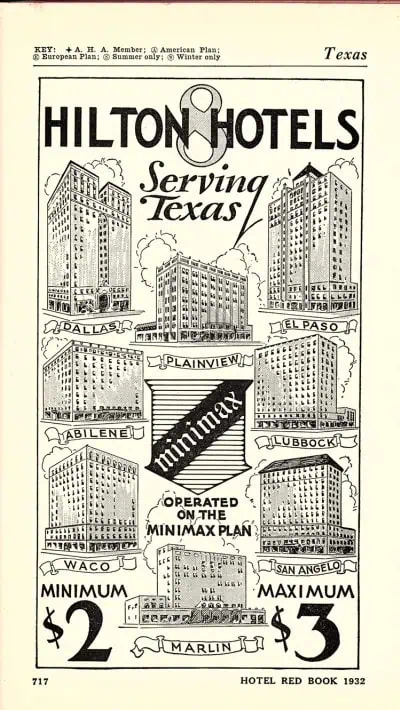
But the $50,000 didn’t last long: four floors short of completion, he was out of money again, endangering the big $500,000 loan. This time he amazingly convinced the landowner to take on the debts and finish the building and own it. Then Connie leased the finished building back from him for $100,000 per year, rather than the original $31,000 per year for the land only. On August 4, 1925, the first Hilton Hotel opened, in Dallas, to great success.
That year, at age thirty-seven, he married the nineteen-year-old Mary Barron of Kentucky, and their first son, Conrad Nicholson “Nicky” Hilton, Jr., was born in July of 1926. The young family moved into a house in the affluent Dallas suburb of Highland Park. In October 1927, a second son, William Barron Hilton, always called Barron, was born.
Riding high on his horse, Connie in 1926 decided to build a new hotel a year, expanding across Texas. But he didn’t do that: he built six hotels in two years, triple his goal. Hilton Hotels were soon found in Abilene, Waco, Marlin, Plainview, San Angelo, and Lubbock, all open by the end of 1928. Over six hundred rooms had been added to the chain, with over $3 million invested ($900,000 in San Angelo alone).
In the fall of 1929, Connie announced his biggest project yet, the $1.75 million, nineteen-story, three hundred-room El Paso Hilton. Nineteen days after the announcement, the stock market crashed.
Surviving the Great Depression
Travel, and with it the hotel business, collapsed during the Depression. It has been estimated that 80 percent of the hotels in the United States went bankrupt, were foreclosed, or were re-organized under bankruptcy and other laws.
Connie, with debt payments, interest payments, and lease payments which were fixed and did not go down, scrambled to hold on. He and his managers scrambled to save every penny, closing off whole floors of some hotels, yanking the phones out of rooms to save fifteen cents, skipping their paychecks and working just for room and board.
No one knew how long this awful situation would continue, but Connie kept telling himself, “If I could just hang on a while longer, things will get better.” He prayed constantly.
In desperation, he traveled to Galveston to meet the powerful and wealthy owners of the American Life Insurance Company, W. L. Moody and his thirty-five-year-old son Shearn. Connie knew it was risky, as their tight-fisted ways, especially those of Shearn, were well-known. After having bad dealings with Shearn, one man had told Shearn, “I’ve always wondered why nine men out of ten who’ve done business with you call you names,” to which Shearn replied, “Because that’s the way I like it. I’d like it better if it was ninety-nine out of a hundred.”
Connie ended up getting a $300,000 loan from the Moodys, with his entire ownership of his hotels as collateral. He thought he had saved the day. But the Depression continued, and the money soon ran out.
“If I can just get another $200,000, I will be ok,” he thought to himself. But no banker, even his friends, would touch him in these perilous times. His attorneys and friends pointed out that he was already $500,000 in debt and should declare bankruptcy, as so many others did. But he saw that as defeat, and felt an obligation to those who had believed in him and invested in his dreams.
“If I could just hang on a while longer, things will get better.”
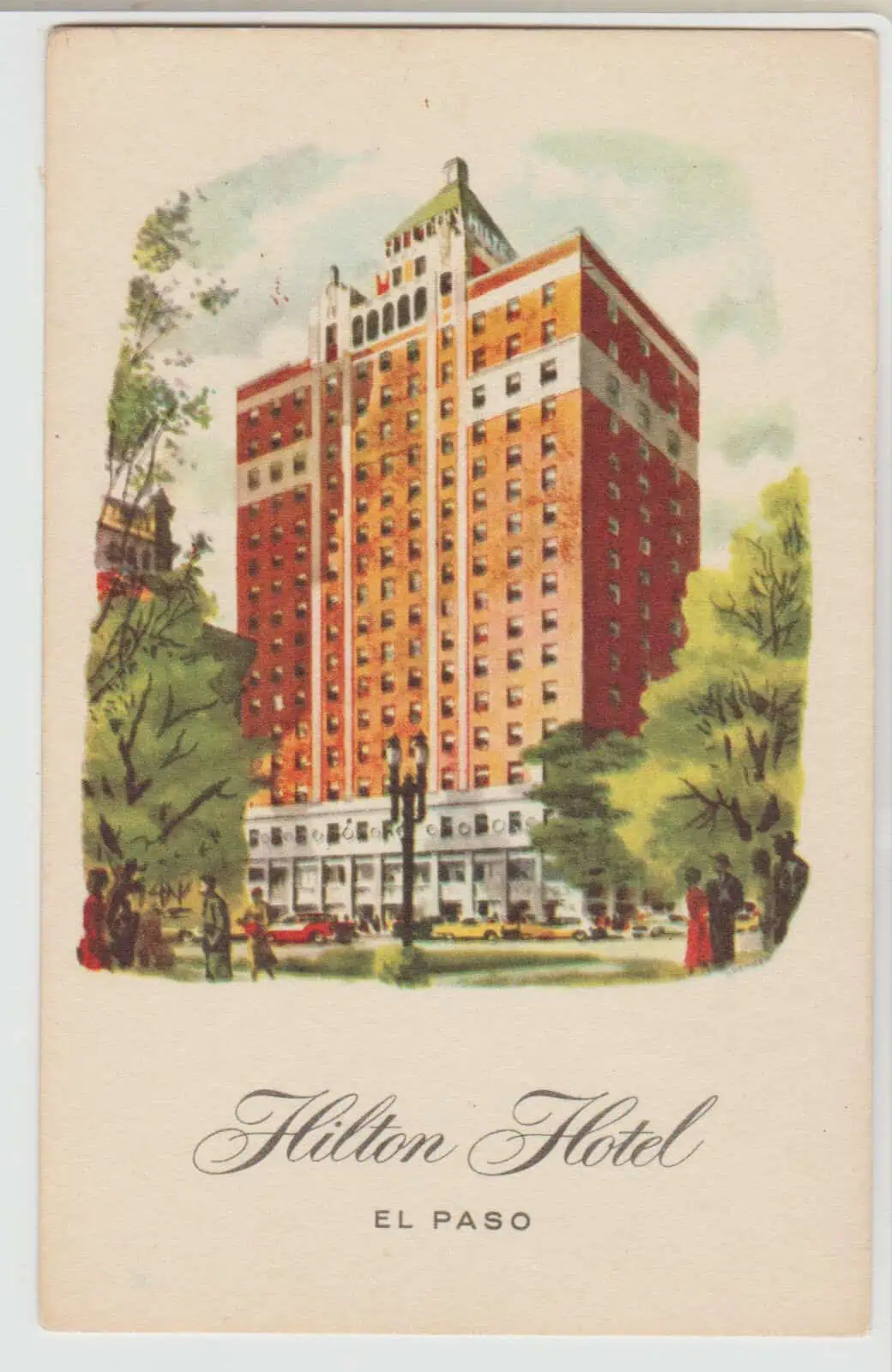
Connie had used every penny at his disposal to save his hotels. Walking through one lobby, a bellboy handed him his life savings of $300 and said, “I believe in you.” When he filled up his car with gas, the station attendant told him he’d been ordered to cut off his credit, but had filled the last two tanks on his own nickel. When he could not pay the rent on their house or keep it stocked with groceries, Connie moved his family out of Highland Park and to the El Paso Hilton, where at least they had room and board. Borrowing carfare, Connie rushed from hotel to hotel trying to borrow money, cut expenses, whatever it took.
But being a man of dreams and faith, the smallest thing could give him hope. Traveling across Texas on a train, he opened a magazine, and there was the story of the December 1931 grand opening of the “new” Waldorf-Astoria in New York, the greatest hotel in America. With a railroad siding for private cars of the wealthy in the basement and two thousand rooms, there was nothing like it. Connie clipped the article and stuck it in his pocket.
The Moodys saw no hope, and were ready to foreclose, taking over his entire chain and leaving him out in the cold. Even his family would no longer have the security of living in the El Paso Hilton. Connie dashed to Galveston, where the more honorable Moody, the elder W. L., suggested they merge Connie’s chain with their own group of ailing hotels across Texas and the south. They’d create the National Hotel Company, with Connie as manager and one-third owner. He’d receive a salary of $18,000 per year. Connie agreed, but requested one more provision—that if they did not get along, and split up, he’d get one-third of the hotels and they’d get two-thirds of them. He coaxed the elder Moody into signing that into a contract.
Again, Connie felt he had saved the day, and his spirits took a huge rise. Connie paid back the bellboy (and later gave him stock which paid dividends for the rest of his life), paid back the gas station attendant, and resumed salaries for his managers on top of their room and board.
He set about fixing up the distressed chain the Moodys had operated. But every time he wanted to spend money to make an improvement, Shearn Moody stepped in and vetoed it. If a manager followed Connie’s orders and spent some money, Shearn docked the amount out of the manager’s paycheck. Connie’s salary was not paid. As the Depression wore on, Shearn also stopped paying required payments on some of the hotels that Connie had contributed to the partnership, risking their loss. It was an untenable situation. Connie went to W. L. to complain, but the old man stood behind his son. When Connie tried to exercise his right to take back one-third of the hotels, Shearn said the contract was meaningless. The Moodys sued Connie to force him out, and he counter-sued them. But Connie did not have the funds they had to fight the legal battle, and he knew such a fight could drag on for years. The future had never looked darker.
Then Connie got word that Shearn was going to stop paying the lease on the El Paso Hilton. The landlord did not want the hotel back, and told Connie he could take it over if he came up with just $30,000 to cover the past-due lease payment. Only a few years earlier, Connie had easily raised $1.75 million to build the hotel, but now no lender would lend him the measly $30,000. One Dallas insurance company president promised to loan him the money, but curtly backed out at the last minute. Time was running out to come up with the $30,000.
But again, Connie “pulled one out of the hat”—or his prayers paid off. In the fall of 1933, he got seven people to each put up $5,000. But this time they included the owner of a laundry company, the owner of a dairy, and the representative for Blatz Beer, all of whom Connie promised the business of the El Paso Hilton—“forever.”
In the midst of all this, in July of 1933, Connie and Mary had their third son, Eric Michael Hilton.
Soon enough, Connie also got back the Abilene hotel when the Moodys let it go. And then, in early 1934, he settled with the Moodys, getting back his hotels in Dallas, Lubbock, and Plainview. He was at last back on his feet.
All this commotion and his continual travel had stressed his marriage, and in 1934 he and Mary divorced, though they remained friends. He raised Nicky and Barron, and she remarried and raised Eric, though all three boys eventually worked in his hotels.
Coming Back Strong after the Fall
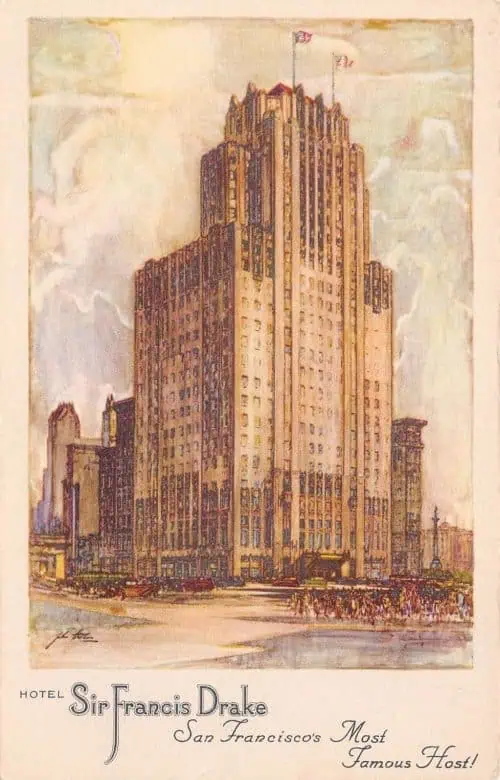
Perhaps the Depression was a blessing in disguise for Conrad Hilton, because it meant that the hotel market was distressed, and many hotels were for sale cheap. He bought the Paso del Norte in El Paso and the Gregg in Longview.
In 1937, he made his first move outside of Texas by buying the historic Sir Francis Drake near Union Square in downtown San Francisco. It had cost $4.1 million to build, but Connie got control for a cash outlay of only $275,000.
Connie bought a big house in the fancy Bel Air section of Los Angeles, not far from Beverly Hills.
Always a dreamer, and of course a lover of great hotels, Connie now set his sights on Chicago, which had always seemed to him a city full of life. Chicago contained the largest hotel in the world, the Stevens, and Connie wanted it badly.
Built in 1927 by the Stevens family—their nephew was future Supreme Court Justice John Paul Stevens—the hotel had succumbed to the Depression like most of the industry. It now was in reorganization with six thousand stockholders. Connie went to Chicago, where the manager gave him a personal tour: three thousand rooms, all with baths, a hospital with an operating room, dry cleaning facilities that could handle five hundred suits a day, banquet facilities that could serve eight thousand at one sitting, use of a thousand pounds of butter and a thousand dozen eggs per average day, production of seven hundred gallons of coffee a day, and a mechanical dishwashing system that could clean 193,000 pieces of china and silver an hour. It took one’s breath away, especially Conrad Hilton’s!
Connie, using a method he was to repeat in this era, began buying up the bonds of the Stevens, at 20 cents on the dollar of face value. He urged his friends to do the same. Over time, he accumulated bonds totaling $400,000 in face value. If the hotel came up for sale, he knew he’d be in a priority position as a major bondholder. Also continuing his pattern, he sold the Sir Francis Drake for a $500,000 profit.
In December of 1941, he met the beautiful young Hungarian Zsa Zsa Gabor. Then came Pearl Harbor on December 7, and his marriage to Zsa Zsa the following April. But his eyes were still on more hotels.
“Success … seems to be connected with action. Successful men keep moving. They make mistakes, but they don’t quit.”
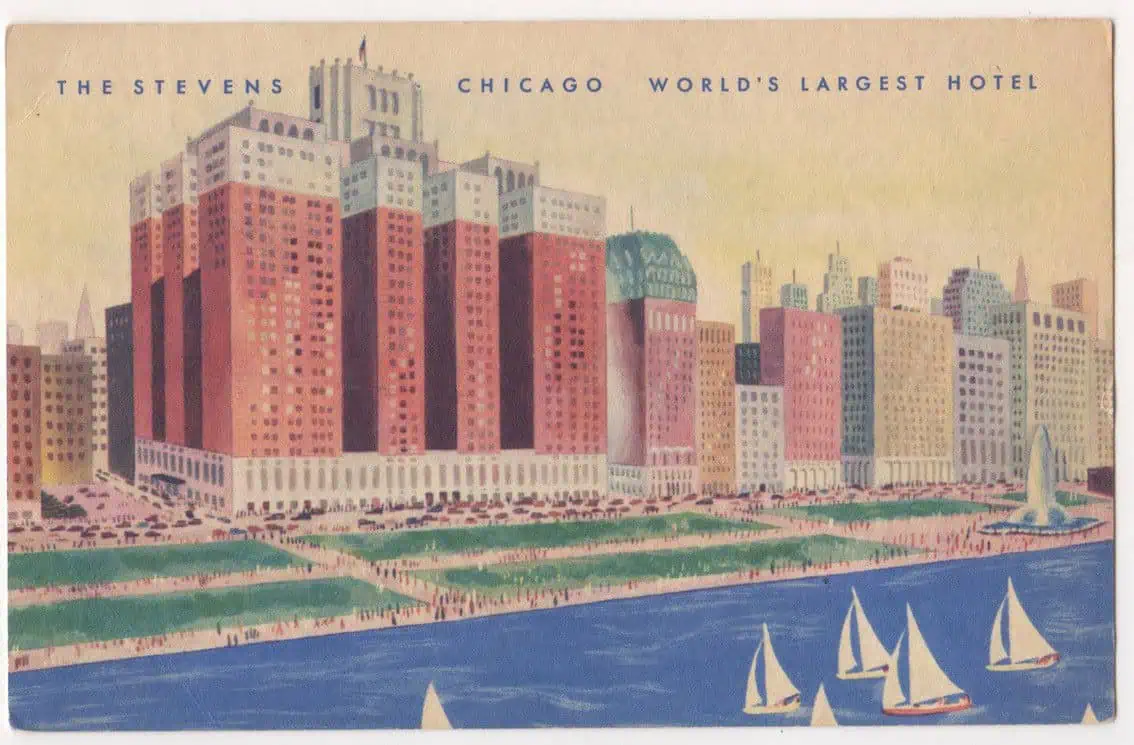
First, he bought the Town House in Los Angeles, which was making a profit of $33,000 a year. He soon had it making $250,000 year-in, year-out. Next, he made his first international effort, building the Palacio Hilton in Chihuahua, Mexico, with local partners.
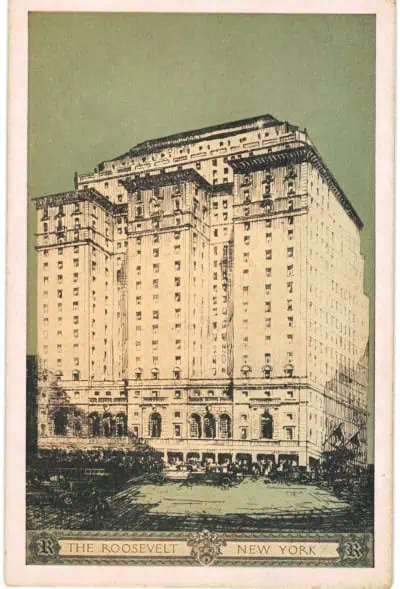
In 1942, the federal government took over the Stevens in Chicago to use as housing for the Air Force. As part of the deal, they paid off all the bonds at face value. The $400,000 check that Connie received was the largest of his life.
Then came the long-awaited opportunity to invade New York City. The East Coast hotel market was particularly overbuilt and depressed. With the uncertainties of war—supply shortages, rationing, limited labor availability, and price controls—everyone was nervous about the future. Financial types thought the “wild man from the West” was a sucker; New York elites feared he might ride into town on a horse. But he got control of the Roosevelt Hotel, adjoined to Grand Central Station with its own tunnel, and home to the famous Guy Lombardo Orchestra in the Roosevelt Grill. He quickly brought the hotel up to Hilton standards and began to win praise.
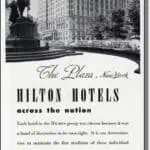
His eyes were still on the incredible Waldorf-Astoria. He began to buy its distressed bonds at 4.5 cents on the dollar. Wall Street now knew he was a sucker. He convinced friends to join him, but they came with great hesitation. Connie later sold the bonds at eighty-five cents on the dollar, turning $22,500 into $500,000. The man knew hotels, and had more faith in the future than anyone around him. Maybe St. Joseph was listening to his prayers.
Back in Chicago, while the government had the Stevens hotel itself, they did not want the Stevens Corporation, a separate company with various inventories and assets. They put it up for sale and took sealed bids. Connie at the last minute raised his bid to $180,000. He won the bidding, with the second highest bidder coming in at $179,800. He had his foot in the door—by the narrow margin of $200!
With his reputation in the East rising, the investment company the Atlas Corporation asked him to partner with them in the purchase of the legendary and elite Plaza Hotel facing New York’s Central Park. This home to high society was built at a cost of $17 million in 1907 ($460 million today). It was the home of Eloise, the main character in a series of bestselling children’s books, and the location of novels and movies. Connie ended up owning 60 percent of it, with Atlas holding 40 percent—they bought it for $7.4 million, but a cash outlay of only $600,000. In remodeling the Plaza, which had become run-down, Atlas and Connie spent another $6 million but had to tip-toe around at night, avoiding noise and dust. He found “waste space” but also brought it back to its former glory. Occupancy went from 61 percent to 100 percent. He later parted with this beauty, as well as the Roosevelt. It was the Waldorf that he really wanted.
But then came opportunities in Chicago.
The (Hotel) Battle of Chicago
As World War II came to an end, the War Department no longer needed the Stevens, now a rough barracks stripped of all furnishings, its elegant ballrooms in decay. The government put it up for sale. Here Connie made one of his few mistakes. He figured “no sensible hotel man would bid enough to get the hotel.” So he did not bid. He would bide his time.
He was right—no hotel man did make an adequate offer. But millionaire Chicago contractor and former bricklayer Stephen Healy did. Much to Connie’s shock and dismay, Healy called on his suppliers and huge labor force and soon enough fully restored the beautiful, enormous hotel. Connie figured Healy had fun redoing it, but might now get bored with operating it.
At this point, Connie boarded a train from California to Chicago, telling friends and family, “I am not going to leave Chicago until I get that hotel.” In their first meeting, Healy shook hands on a deal to sell Connie the Stevens for a $500,000 profit over what he had invested in it. Connie was ready to move ahead quickly, but then Healy disappeared and did not respond to calls. Eventually, Healy showed up and wanted a $650,000 markup. Connie irritatingly accepted the raise. Again, Healy was nowhere to be found. Connie hated liars and fast-dealers, and was losing his patience, but then Healy came back and wanted a million-dollar profit on the Stevens. One last time, Connie agreed. Then, of course, no sign of Healy. It finally seemed like this deal was dead, and Connie would never “get his girl.”
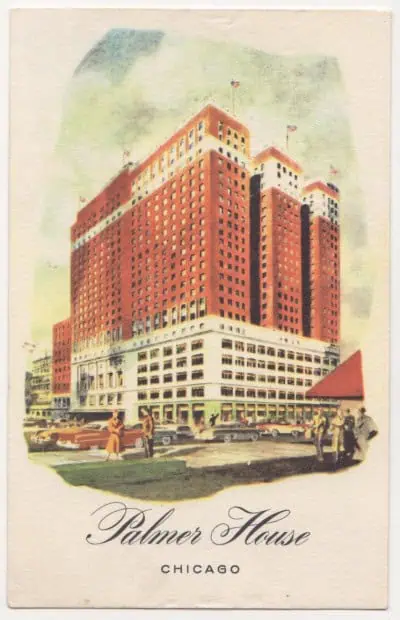
In the meanwhile, Connie’s friend and Chicago industrialist Henry Crown suggested he might try to buy the Palmer House, the grand lady of Chicago’s Loop hotels. Originally built by Marshall Field’s former partner Potter Palmer, this beauty was a treasure, with its famous Empire Room where every major star had performed. Potter Palmer was long dead, so Connie met with the trustee of the estate, and offered him $18.5 million for the hotel, subject to a review of the hotel’s books. Soon the trustee got word that Connie was trying to buy the Stevens, and said, “We cannot show our records to someone who might become a competitor.” Connie convinced him that the Stevens deal was dead, that there was no way he was going to own that hotel. Upon review of the books, Connie found that the Palmer House had made a gross operating profit of $1.36 million even in 1933, in the depths of the Depression. It looked like the Palmer House was his.
Just then Stephen Healy reappeared out of the woodwork, saying he’d sell the Stevens for a $1.5 million profit. Connie didn’t trust him, and demanded he sign the paperwork then and there. Healy did, and Connie now captured his treasure.
But then he was in the doghouse back at the Palmer House. They would never believe him again, since he told them the Stevens deal was off. But he convinced them of his honesty, and bought the Palmer House for the slightly higher price of $19,385,000. Unlike Healy, the trustee was good for his word and the deal closed on a handshake, with no lawyers or advisors in the room. He even turned down a higher offer for the hotel, because he had agreed to sell it to Connie.
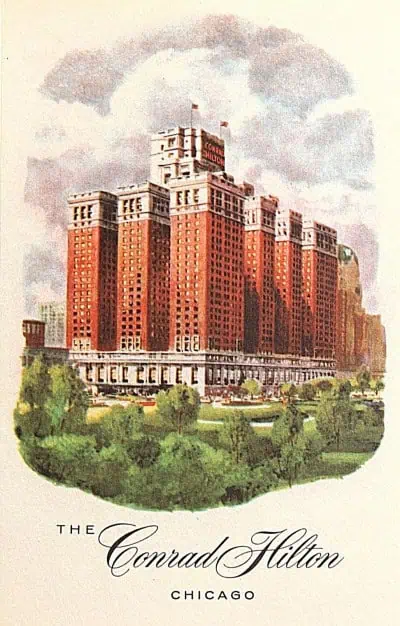
So in 1945, Conrad Hilton ended up, after months of struggle, returning to California with two of the greatest hotels in America and a key position in the Chicago hotel market. Under his management, he found plenty of “waste space” at the Palmer House, adding sixty bedrooms and more shops, boosting the hotel’s annual profit to $1.75 million per year. In 1951, his board of directors renamed the Stevens “The Conrad Hilton.” In 1984, it was closed for a year for a $185 million renovation, the most expensive in hotel history. The three thousand rooms were converted to 1,544 larger ones, reopening in 1985 as the Chicago Hilton and Towers. Again, in 2012, the company invested $150 million to keep the hotel up to the highest standards, and it is now known as the Hilton Chicago. The ballrooms and public spaces are among the most beautiful in America. Every US President since its 1927 opening has slept at this amazing, massive hotel.
But Connie still did not own the Waldorf-Astoria!
Big Business, Big Trophy
In May 1946, the Hilton Hotels Corporation was created. All Connie’s partners in the various deals received common or preferred stock for their interests. But Connie gave the Longview, Texas, Hilton to his managers, with the purchase price paid out of the hotel’s earnings. He figured they deserved something for their many sacrifices for him and the company. The Roosevelt and the Palacio in Chihuahua were not included in the new company, which owned nine hotels. Connie had invested a total of $2.2 million, and now his stock in the new company was worth $9.2 million. The company’s slogan changed from “Minimax” to “Across the Nation.”
In 1946, he also got control of Washington’s pretty and prestigious Mayflower Hotel, home to as much political intrigue as any US hotel, though this is another one he later parted with.
“To me it is part of the hotel game, or any business, to let the past go cleanly if you are sacrificing it to an expanding future.”
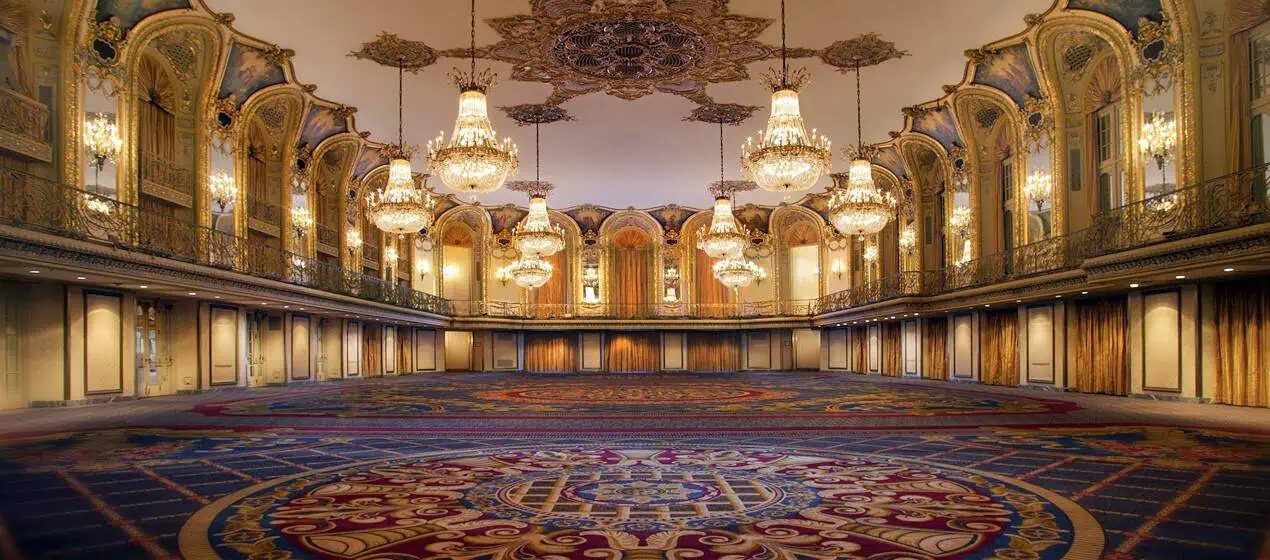
That fall, his mother turned eighty-five and they had a big party. She asked Connie, “Now that you are all across America, are you satisfied?” Connie answered, “No, I haven’t got the greatest of them all. But I’ll get it.” Mary Laufersweiler Hilton passed away the following spring.
The focus of his dreams, the Waldorf-Astoria, might be the most historic hotel in America. Originally built as two adjacent hotels, the Waldorf and the Astoria were built out of spite by two branches of New York’s wealthy Astor family. Eventually they merged. The hotel became the site of every major charity event and ball for New York’s elite. Its “Peacock Alley,” named for the opulent wardrobes and jewelry of the wealthy, was the place to be seen.
In the 1920s building boom that swept the country, the old hotel was demolished to make way for the Empire State Building. But hotel impresario Lucius Boomer bought the name rights, and in 1931 opened the stunning new Waldorf-Astoria on Park Avenue just north of Grand Central Station. It soon became the preferred stop for royalty and celebrities. During World War II, the elites of Europe took refuge there. When the telephone switchboard received calls asking to speak to “the king,” the operators had to say, “Which one?” Despite its prominence, the expense of operations combined with the vagaries of depression and war prevented it from becoming profitable, or covering its mortgage. That’s why Connie was able to buy and sell their bonds for pennies on the dollar.
Now it was time for Conrad to acquire his biggest trophy yet. Nevertheless, his board of directors in the new Hilton Corporation fought him on the idea of buying the money-losing “white elephant.” They finally gave in, but not without reservations—the head of Paramount Pictures, Frank Freeman, said, “Ok, you can try to buy it, but I sure hope you don’t succeed.”
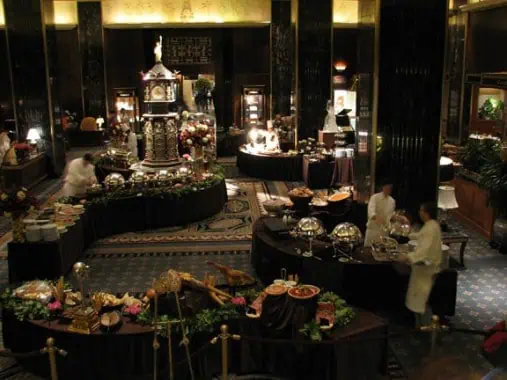
On October 12, 1949, the Hilton company gained control of the building and management contract for between $3 and 4 million. In 1977, they bought the land underneath the hotel from the corporate descendants of the New York Central railroad. Unsurprisingly, the Waldorf became a huge success for Hilton. He even found a little “waste space”—building display cases for jewelry stores to rent into the four columns in Peacock Alley. In 2012, the company sold the building to the Chinese Anbang Insurance Company for $1.95 billion! But Hilton retained operating rights many years into the future. As of this writing, the hotel is closed while some rooms are converted into condominiums for New York’s superheated housing market. The hotel is expected to re-open in 2020.
Conrad Hilton was now a wealthy man. In 1950 he paid $225,000 to buy Casa Encantada, a huge home and estate in Bel Air, near Beverly Hills, which had cost $2.5 million to build in the 1930s. After his death, it changed hands, and most recently sold for about $95 million in 2000. More recent estimates place its value at over $200 million. Connie certainly had an eye for good value!
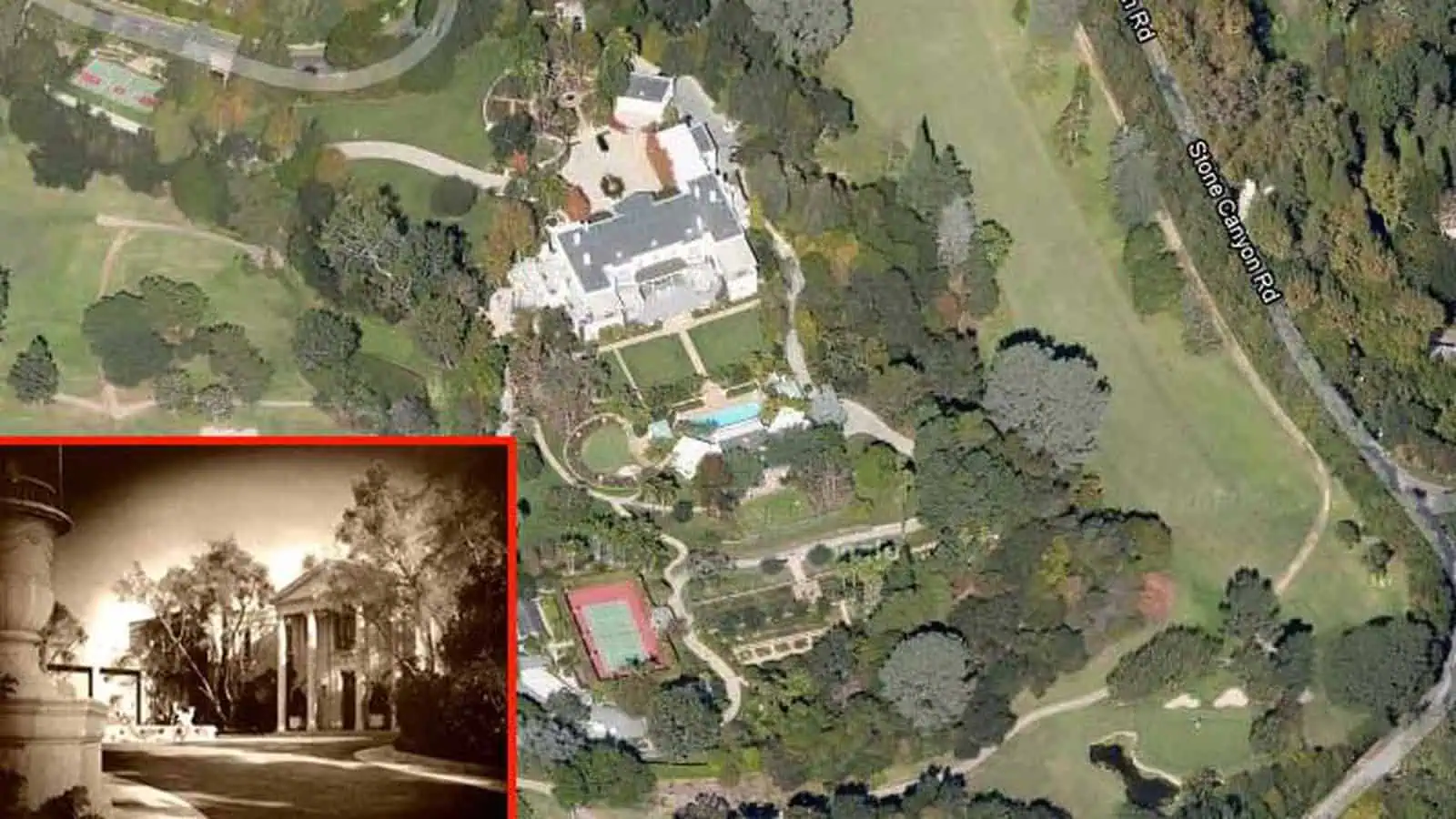
Bigger and Broader
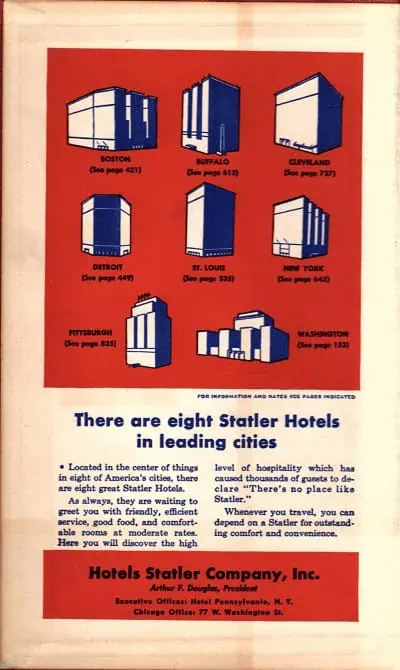
While it can be said with some truth that Conrad Hilton built the first great American hotel chain, the same might be said of Ellsworth M. Statler. Beginning by operating temporary hotels at the World’s Expositions in Buffalo and St. Louis in the first decade of the twentieth century, Statler went on to build a highly regarded chain of big city hotels. Statler was famous for his hotel innovations and standards of operation. These hotels were already famous when Hilton was just building his Texas chain. Largest of all was the Hotel Pennsylvania (later Hotel Statler), facing Penn Station, which at its 1919 opening was the largest hotel in Manhattan, designed by New York’s top architectural firm, McKim, Mead, and White. This hotel’s telephone number became a famous Glenn Miller song, “Pennsylvania 6-5000.”
After Statler’s death in 1927, the company continued to build new hotels, including in Washington, Los Angeles, and Dallas. By the early 1950s, Statler’s widow, Alice, was ready to sell, and agreed to an offer from famous New York real estate developer William Zeckendorf. While Zeckendorf was working to put his financing together, Connie (again against his board’s advice) rushed to New York and convinced her that the hotels would be better off in the hands of a hotel man. On October 27, 1954, Connie handed her a check for $111 million, the biggest real estate transaction in history up to that point. This about doubled Hilton’s hotel count.
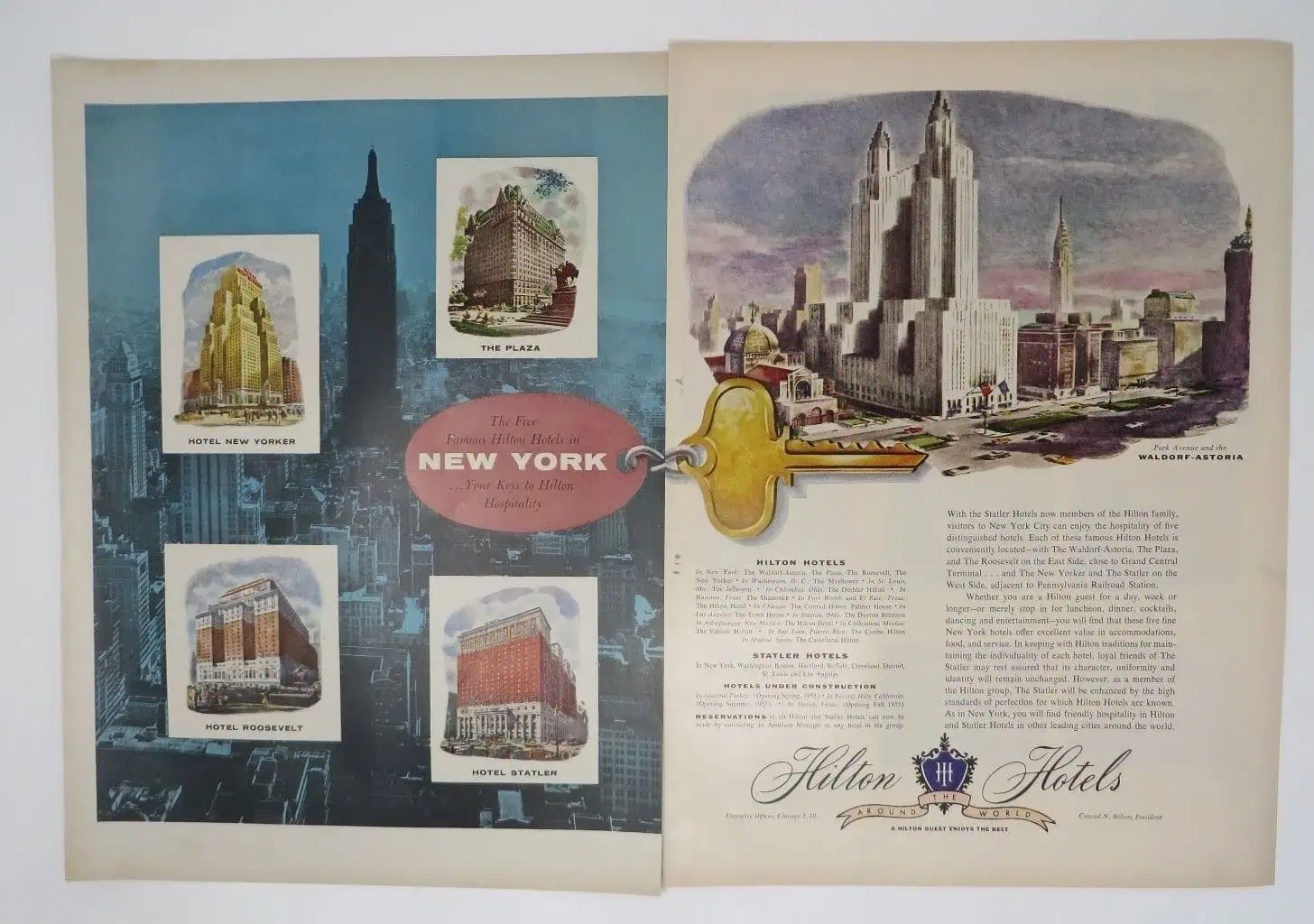
As Conrad became more famous and more important in the business world, he was increasingly asked to give talks and share his philosophies. He often spoke to ecumenical councils which united Christians, Jews, and other religions, in tune with his own beliefs. In these and his other talks at hotel conferences, he made clear his virulent anti-communism. With the Cold War at its height, he was especially concerned about the one billion people living in “non-aligned nations”—countries like Indonesia, India, Egypt, and Turkey which had neither declared for the Soviets or the “Western democracies,” often trying to leverage the two sides against each other.
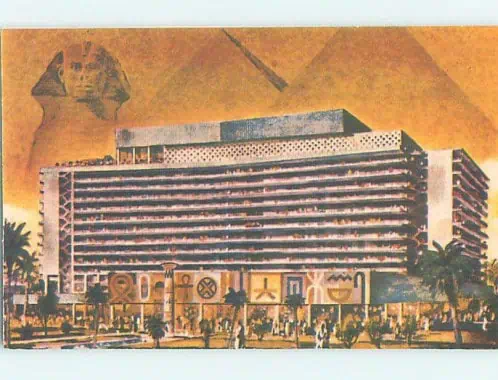
When he went to his board with the desire to seriously expand abroad, they again hesitated, but agreed to it if he set up a separate international subsidiary, Hilton International, which he did in 1948. Over time, Hiltons opened in San Juan, Puerto Rico, Mexico City, Madrid, and other cities, working with local partners and hiring and training local workers. But Connie’s goal was as much political as financial. The Soviets were willing to build big hotels in those non-aligned nations, but Connie thought they knew nothing about hotel operation. The ideally sited Istanbul and Cairo Hiltons came along quickly, and were soon the centers of activity and conferences in those cities. Havana, West Berlin, and Montreal opened in short order.
“To accomplish big things, I am convinced you must first dream big dreams.”
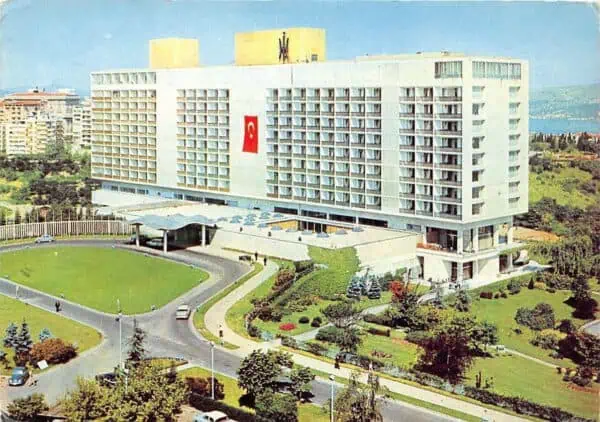
With these steps, the Hilton company became the first true international hotel organization. In 1964, Hilton spun out International as a separate public company, which was then acquired by Trans World Airlines (TWA) in 1967. In 1986 United Airlines took over, and in 1987 the British Ladbroke Group got it. Finally, in 2006, the US Hilton company corrected the mistake of breaking up the company, and reacquired its wandering international child and its hotels spanning the globe.
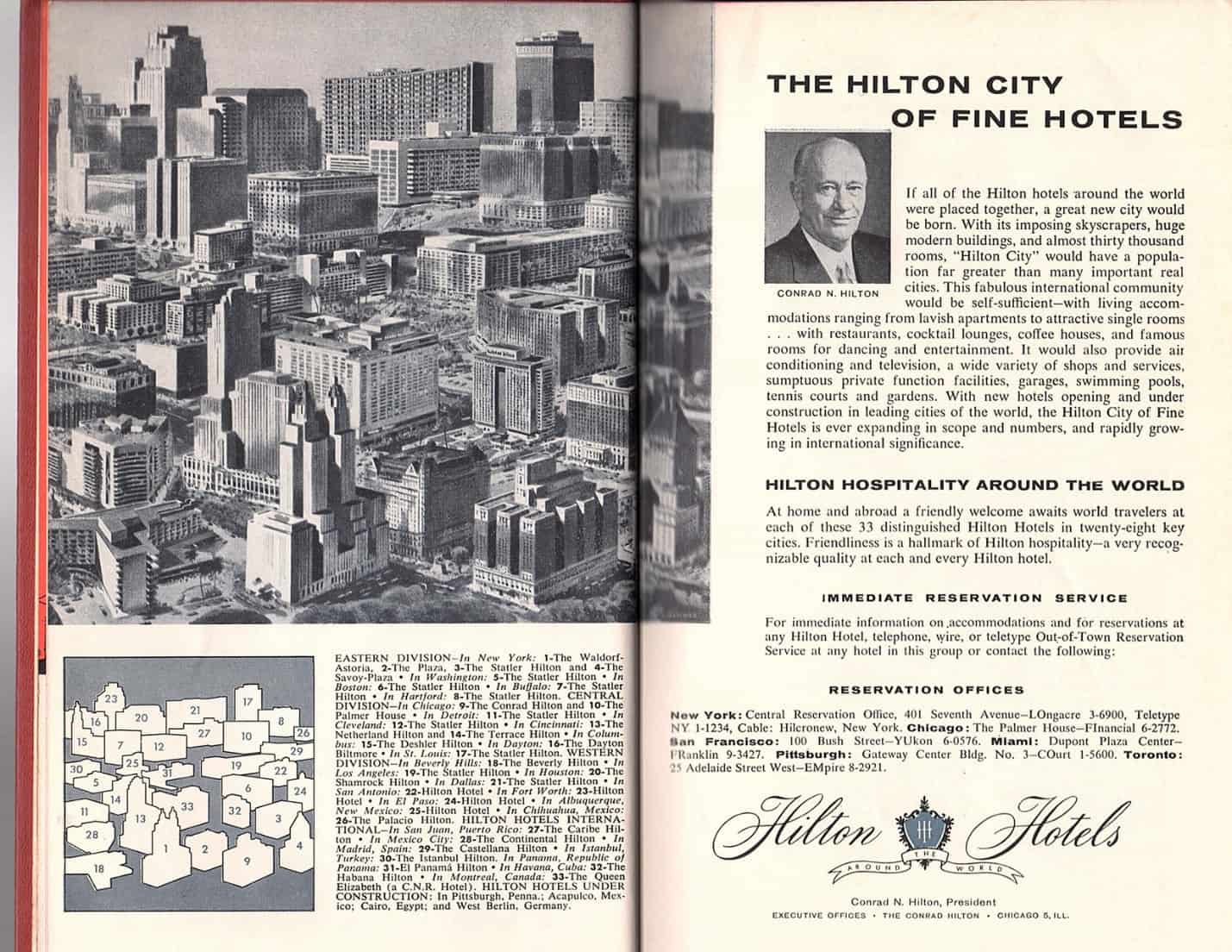
Conrad Hilton’s Operating Rules
In his 1957 autobiography, Be My Guest, Connie spelled out the company’s key ideas:
- Each hotel has its own personality.
- Forecasting—knowing the seasonality of the business and adjusting accordingly.
- Mass purchasing for the whole chain to save money.
- Digging for gold—finding “waste space” and wringing profits out of it.
- Training, including the use of hotel schools (Conrad funded the Hilton School at the University of Houston).
- Powerful sales, advertising, and publicity, including groups and conventions.
- Integrated reservations systems to make it easy for guests to book Hilton hotels.
Rules for Living
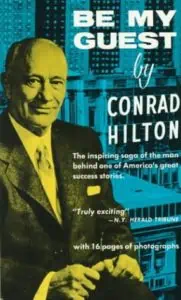
In the same autobiography, Connie laid out his “rules for living”:
- Find your own particular talents.
- Be big. Think big. Act big. Dream big.
- Be honest.
- Live with enthusiasm.
- Don’t let your possessions possess you.
- Don’t worry about your problems.
- Don’t cling to the past.
- Look up to people when you can, down to no one.
- Assume your share of responsibility for the world in which you wish to live.
- Pray consistently and confidently.
Conrad Hilton the Man, Husband, and Father
As indicated in the preceding sections, Conrad Hilton was one of the most impressive business leaders that this writer has ever studied. Years in advance of today’s rising “Conscious Capitalism,” he honored and served all his “stakeholders”—customers (“guests”) first, but also suppliers, employees, partners, lenders, and stockholders. Even those banks which rejected him in the Depression went on to finance his many later dreams, because they trusted him. He was a great salesman, but above all brutally honest at every stage. Without this integrity, he never would have left Chicago with two hotels when his goal was one.
Hilton became a national figure whose opinions were quoted and respected. He went beyond that to be a player on the global stage, an ambassador for world peace and cooperation. He was friends with everyone from presidents and movie stars to bellhops.
At the same time, little has been said here of his home life. It was not a success. While his honest, heartfelt, and well-written autobiography touches on it, all the sad details can be found in the book The Hiltons: The True Story of an American Dynasty, by J. Randy Taraborrelli, which even covers Connie’s great-granddaughter, Paris Hilton.
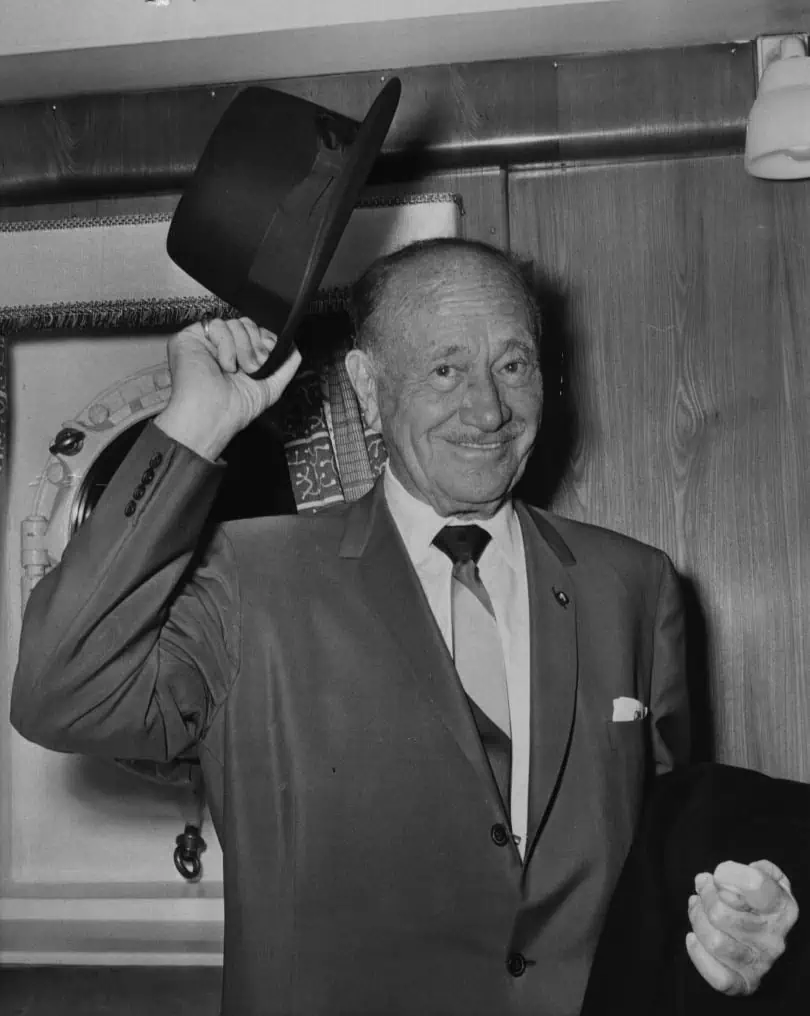
Connie Hilton was a man who lived, as he recommended, with enthusiasm. His book is filled with pretty girls and lots of dancing. But a close reading makes the reader think he only loved two women in his life—his mother, Mary Laufersweiler Hilton, and his long-time secretary and assistant, Olive Wakeman, who joined him in 1942 and organized his life and work for decades. Perhaps he also loved his first wife, Mary Barron, but was too busy trying to save his hotels in the Depression to give her the time and attention she desired; the marriage lasted only nine years, though they remained friends.
While they lived in a veritable palace, Connie struggled with raising his first two sons, the beloved and lively Nicky and the more serious Barron. He wanted to pass on to them his work ethic, not his wealth. With one he succeeded, with the other he didn’t. Nicky, after marrying beautiful young actress Elizabeth Taylor for a few months, had another tortuous marriage that lasted years. But his life of partying, gambling, and drinking ended in a fatal alcohol-related heart attack at the age of forty-two.
Barron, on the other hand, despite troubles in his youth, went on to become the very successful chief executive officer of the Hilton company and an active and famous aviator, including efforts to fly around the world. He was married to the same woman for fifty-seven years, until her death. As of this writing, he is still going at age ninety.
For four years, Connie was married to Zsa Zsa Gabor, a Hungarian beauty who was twenty-five years old when she married the fifty-four-year-old Hilton. This was not a happy affair and ended in flames. Among other things, at that time the Catholic Church did not recognize divorce, so Conrad’s first marriage had “never ended” and he was banned from taking Communion once he married Zsa Zsa. This tortured Connie until he divorced her. Gabor later claimed she had had an affair with stepson Nick. And there was even speculation of the paternity of her child with Conrad, Francesca, but Connie never challenged it.
Connie married one more time, for the last two years of his life.
Conrad Hilton died at the age of ninety-one on January 3, 1979.
What is clear from this story is that Conrad Nicholson Hilton was obsessed. He loved the hotel business and he loved every one of his hotels, even the ones he parted with. He loved the people who worked hard with him to build the chain, and rewarded them handsomely. Perhaps that obsession inhibited his ability or willingness to invest the time and energy required in relationships outside of work. Perhaps that is tragic, but it is also clear that Conrad Hilton enjoyed his life and lived it with passion.
Afterword
Today, with many industry changes, including Marriott’s acquisition of Starwood (including long-time Hilton competitor Sheraton and W), Hilton is no longer the world’s largest hotel operator, though it is still near the top of the list. Under Barron Hilton and his successors, the company has gone on to great success based on his father’s foundations. Still built upon the rocks of the Hilton Chicago, Palmer House, and Waldorf-Astoria, the company went on to become a major force in Las Vegas, and in hotels and resorts around the world. They expanded with the Hampton Inns, Hilton Garden Inns, upscale Waldorf-Astoria and Conrad, and other brand names covering the lodging gamut.
As of this writing, the parent company, now named Hilton Worldwide Holdings, has a market value of $26 billion. Barron alone is worth over $2 billion. The company reports that its fourteen brands consist of over 4,900 properties with more than 800,000 rooms in 104 countries, with over 160,000 employees. 157,000 additional rooms are under construction.
All this started with one man who could not buy a bank in Cisco, Texas. Of such history are legends made.
Sources
This profile is largely based on Conrad Hilton’s 1957 autobiography, Be My Guest, which the company distributed in all its hotel rooms for many years. This is one of the best and most honest business biographies ever written. Other sources include The Hiltons by Taraborrelli, noted above, company annual reports, and Wikipedia. More information on the great hotels in this story can be found on Wikipedia and across the Internet. The book Building the Cold War: Hilton International Hotels and Modern Architecture, by Annabel Jane Wharton, is also an excellent source for information on the Istanbul and other hotels and the thinking behind them.
Gary Hoover has founded several businesses, each with the core value of education. He founded BOOKSTOP, the first chain of book superstores, which was purchased by Barnes & Noble and became the nucleus for their chain. He co-founded the company that became Hoover’s, Inc. – one of the world’s largest sources of information about companies, now owned by Dun & Bradstreet. Gary Hoover has in recent years focused on writing (multiple books, blogs) and teaching. He served as the first Entrepreneur-In-Residence at the University of Texas’ McCombs School of Business. He has been collecting information on business history since the age of 12, when he started subscribing to Fortune Magazine. An estimated 40% of his 57,000-book personal library is focused on business, industrial, and economic history and reference. Gary Hoover has given over 1000 speeches around the globe, many about business history, and all with historical references.

